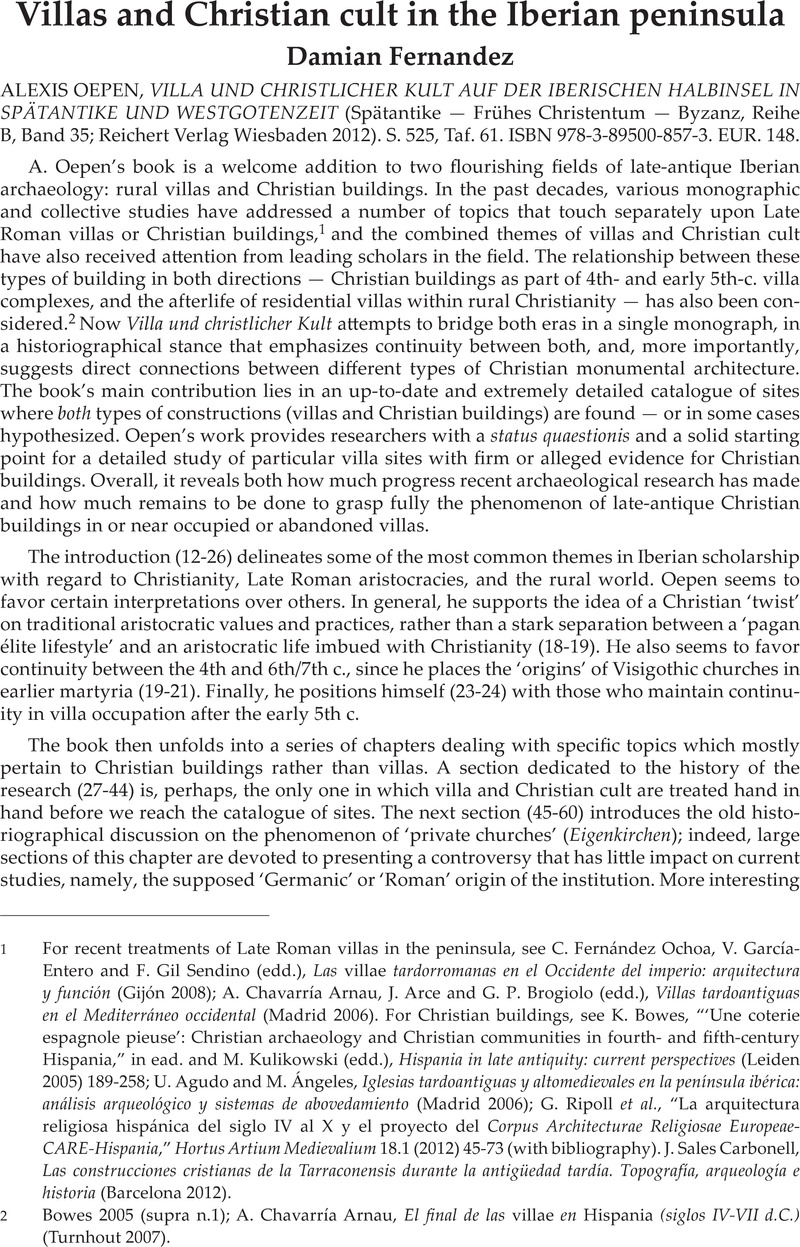No CrossRef data available.
Published online by Cambridge University Press: 27 November 2014

1 For recent treatments of Late Roman villas in the peninsula, see Ochoa, C. Fernández, García-Entero, V. and Sendino, F. Gil (edd.), Las villae tardorromanas en el Occidente del imperio: arquitectura y función (Gijón 2008)Google Scholar; Arnau, A. Chavarría, Arce, J. and Brogiolo, G. P. (edd.), Villas tardoantiguas en el Mediterráneo occidental (Madrid 2006)Google Scholar. For Christian buildings, see Bowes, K., “‘Une coterie espagnole pieuse’: Christian archaeology and Christian communities in fourth- and fifth-century Hispania,” in ead. and Kulikowski, M. (edd.), Hispania in late antiquity: current perspectives (Leiden 2005) 189–258 CrossRefGoogle Scholar; Agudo, U. and Ángeles, M., Iglesias tardoantiguas y altomedievales en la península ibérica: análisis arqueológico y sistemas de abovedamiento (Madrid 2006)Google Scholar; Ripoll, G. et al., “La arquitectura religiosa hispánica del siglo IV al X y el proyecto del Corpus Architecturae Religiosae Europeae-CARE-Hispania ,” Hortus Artium Medievalium 18.1 (2012) 45–73 CrossRefGoogle Scholar (with bibliography). Carbonell, J. Sales, Las construcciones cristianas de la Tarraconensis durante la antigüedad tardía. Topografía, arqueología e historia (Barcelona 2012)Google Scholar.
2 Bowes 2005 (supra n.1); Arnau, A. Chavarría, El final de las villae en Hispania (siglos IV-VII d.C.) (Turnhout 2007)Google Scholar.
3 Wood, S., The proprietary church in the Medieval West (Oxford 2006)CrossRefGoogle Scholar.
4 Teichner, F., Zwischen Land und Meer — Entre tierra y mar. Studien zur Architektur und Wirtschaftsweise ländlicher Siedlungen im Süden der römischen Provinz Lusitanien (Mérida 2008) 250-55Google Scholar.
5 Bowes, K., “Building sacred landscapes: villa and cult,” in Chavarría Arnau, Arce and Brogiolo (supra n.1) 73–95 Google Scholar.
6 Arnau, A. Chavarría, “ Splendida sepulcra ut posteri audiant. Aristocrazie, mausolei e chiese funerarie nelle campagne tardoantiche,” in Brogiolo, G. P. and ead. (edd.), Archeologia e società tra tardoantico e alto medioevo (Mantova 2007) 127-46Google Scholar.
7 Brown, P., Through the eye of a needle: wealth, the fall of Rome, and the making of Christianity in the West, 350-550 AD (Princeton, NJ 2012)Google Scholar, reviewed in this issue by J. Howard-Johnston.
8 Munro, B., “Recycling, demand for materials, and landownership at villas in Italy and the western provinces in late antiquity,” JRA 25 (2012) 351-70Google Scholar.